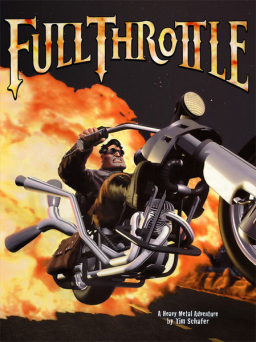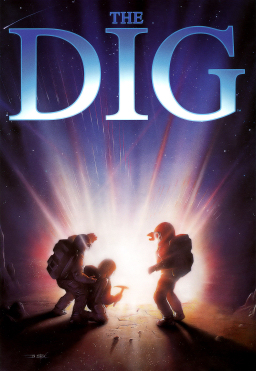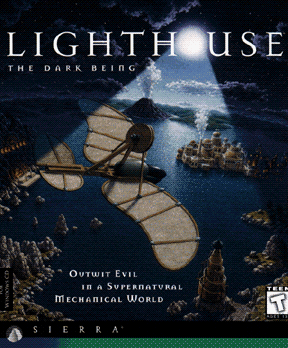
Full Throttle is a graphic adventure video game developed by LucasArts and designed by Tim Schafer. The game was released on April 30, 1995, for MS-DOS and Mac OS. It was Schafer's first game as project lead and head writer and designer, after having worked on other LucasArts titles including The Secret of Monkey Island (1990), Monkey Island 2: LeChuck's Revenge (1991), and Day of the Tentacle (1993). Set in the near future, the game's story follows Ben, the leader of a biker gang, who is framed for the murder of a beloved motorcycle manufacturing mogul and seeks to clear his and his gang's names. A remastered version of the game was developed by Double Fine Productions and was released in April 2017 for Windows, PlayStation 4 and PlayStation Vita, with later ports for iOS and Xbox One.

The Dig is a point-and-click adventure game developed by LucasArts and released in 1995 as a CD-ROM for PC and Macintosh computers. Like other LucasArts adventure games, it uses the SCUMM video game engine. It features a full voice-acting cast, including voice actors Robert Patrick and Steve Blum, and a digital orchestral score. The game uses a combination of drawn two-dimensional artwork and limited, pre-rendered three-dimensional clips, with the latter created by Industrial Light & Magic.

Starship Titanic is an adventure game developed by The Digital Village and published by Simon & Schuster Interactive. It was released in April 1998 for Microsoft Windows and in March 1999 for Apple Macintosh. The game takes place on the eponymous starship, which the player is tasked with repairing by locating the missing parts of its control system. The gameplay involves solving puzzles and speaking with the bots inside the ship. The game features a text parser similar to those of text adventure games with which the player can talk with characters.

Myst IV: Revelation is an adventure video game, the fourth installment in the Myst series, developed and published by Ubisoft. Like Myst III: Exile, Revelation combines pre-rendered graphics with digital video, but also features real-time 3D effects for added realism. The plot of Revelation follows up on plot details from the original Myst. The player is summoned by Atrus, a man who creates links to other worlds known as Ages by writing special linking books. Almost twenty years earlier, Atrus' two sons nearly destroyed all of his books and were imprisoned; Atrus now wishes to see if his sons' imprisonment has reformed them. The player travels to each brother's prison, in an attempt to recover Atrus' daughter Yeesha from the brothers' plot.

Discworld is a point-and-click adventure game, developed by Teeny Weeny Games and Perfect 10 Productions, and based upon Terry Pratchett's novels of the same name. Players assume the role of Rincewind the "wizzard", voiced by Eric Idle, as he becomes involved in exploring the Discworld for the means to prevent a dragon terrorising the city of Ankh-Morpork. The game's story borrows elements from several Discworld novels, with its central plot loosely based on the events in Guards! Guards!

Discworld Noir is a 1999 adventure game developed by Perfect Entertainment and published by GT Interactive. The game is set in Terry Pratchett's satirical Discworld universe, and follows its first and only private investigator as he is given a case leading him into the deadly and occult underbelly of the Discworld's largest city.

Warcraft Adventures: Lord of the Clans is a cancelled graphic adventure game developed by Blizzard Entertainment and Animation Magic from 1996 until 1998. Set in the Warcraft universe after the events of Warcraft II: Beyond the Dark Portal, it followed the orc character Thrall in his quest to reunite his race, then living on reservations and in slavery following its defeat by the human Alliance. Assuming the role of Thrall, the player would have used a point-and-click interface to explore the world, solve puzzles and interact with characters from the wider Warcraft series.

Star Wars: Yoda Stories is a 1997 adventure video game based on the Star Wars franchise developed by LucasArts. The game is the second and last title in LucasArts' Desktop Adventures series, preceded by Indiana Jones and His Desktop Adventures. The game was released in March 1997 for Microsoft Windows and ported to Game Boy Color by Torus Games in December 1999.

Dark Seed is a psychological horror point-and-click adventure game developed and published by Cyberdreams in 1992. It exhibits a normal world and a dark world counterpart, which is based on artwork by H. R. Giger. It was one of the first point-and-click adventure games to use high-resolution graphics, to Giger's demand. A sequel, Dark Seed II, was released in 1995.

Shivers is a single-player horror-themed PC adventure game, released on CD-ROM by Sierra On-Line in November 1995. It was developed with Sierra's Creative Interpreter. Being the first Sierra first-person adventure game, Shivers was compared to contemporary Myst and The 7th Guest, gaining praise mostly for its atmosphere. The game takes place in a fictitious haunted museum.

David Mullich is an American game producer and designer. He created the 1980 adventure game The Prisoner, produced the 1995 adaptation I Have No Mouth, and I Must Scream, and developed Heroes of Might and Magic III and Heroes of Might and Magic IV.

Cyberdreams Interactive Entertainment was a video game publisher located in California that specialized in adventure games developed in collaboration with famous names from the fantasy, horror and science fiction genres between 1990 and 1997.

Torin's Passage is a point-and-click adventure game developed and published by Sierra On-Line in 1995. The game was designed by Al Lowe, author of the Leisure Suit Larry series.

Curse of Enchantia is a graphic adventure game developed and released by the British video game company Core Design for MS-DOS and the Amiga in 1992. The game tells the comic fantasy story of Brad, a teenage boy from modern Earth who was magically abducted to the world of Enchantia by an evil witch-queen. He needs to escape and find a way back to his own dimension.

Lighthouse: The Dark Being is an adventure game developed and published by Sierra On-Line. It was the first and only game designed by Sierra On-Line art director Jon Bock.

Lands of Lore: Guardians of Destiny is a 1997 action role-playing game, second installment of the Lands of Lore series, a sequel to Lands of Lore: The Throne of Chaos. It brought about a drastic change in gameplay style from its predecessor, opting away from the original's D&D turn-based style in favor of more action elements. A sequel, Lands of Lore III, was released in 1999.

Jonny Quest: Cover-Up at Roswell is a computer game released by Virgin Sound and Vision for the series The Real Adventures of Jonny Quest in August 1996.

Phantasmagoria: A Puzzle of Flesh is an interactive movie point-and-click adventure game released by Sierra On-Line. The game was released in North America on November 26, 1996. Though technically a sequel to Roberta Williams' 1995 game Phantasmagoria, Puzzle of Flesh shares no connections with its predecessor in plot nor characters, as Sierra initially intended the Phantasmagoria title to be a horror anthology, with each installment of a different story and style. While not a critical or commercial success, A Puzzle of Flesh, like its predecessor, is remembered for its controversial violent and sexual content, which led the game to be heavily censored or banned outright in several European and Oceanic countries.

Alice in Wonderland is an action-adventure video game published by Disney Interactive Studios. Based on Tim Burton's 2010 film of the same name, it was released in the same week as the film for the Wii, Nintendo DS, Microsoft Windows and Zeebo, with the soundtrack being composed by video game music composer Richard Jacques. The Wii, DS, and PC versions were released on March 2, 2010. The DS game is completely different from the Wii and PC versions.

Anastasia: Adventures with Pooka and Bartok is a Fox Interactive puzzle video game based on the 1997 animated film Anastasia. Released on November 25, 1997, it was produced by David Wisehart. Wisehart also served as voiceover director. The game had an estimated budget of US$800,000.



















